Evaluation of InSAR Tropospheric Delay Correction Methods in the Plateau Monsoon Climate Region Considering Spatial–Temporal Variability
Abstract
:1. Introduction
2. Materials and Methods
2.1. Tropospheric Delay Correction
2.1.1. Empirical Linear Model Correction Method
2.1.2. GACOS Correction Method
2.1.3. ERA5 Dataset Correction Method
2.2. Study Area and Data Processing
2.2.1. Overview of the Study Area
2.2.2. Data Sources
2.2.3. Data Processing
3. Results
3.1. Methods of Analysis and Assessment
3.1.1. Evaluation of the Phase Standard Deviation
3.1.2. Phase–Elevation Correlation Analysis Based on the Pearson Correlation Coefficient
3.2. Representative Case Study
3.2.1. Binchuan and Eryuan in Spring
3.2.2. Yangbi in Winter
3.2.3. Dali in Summer
3.3. Comparison of GNSS and InSAR Deformation Results
3.4. Study Area in Different Seasons
4. Discussion
5. Conclusions
- The Linear method has a good effect in winter with stable convective activity and is suitable for large-scale alpine and gorge areas. However, it is limited to the estimation of vertical stratification delay, which is not applicable in areas with an active atmosphere or a flat terrain.
- GACOS is not suitable as an overall correction method for estimating and correcting the tropospheric delay in a large area. It is more suitable for correcting the tropospheric delay for time periods or small regions where there are regional climate changes.
- The ERA5 method provides good correction results in spring, summer, and autumn in the subtropical monsoon climate zone. The high temporal and spatial resolution of the ERA5 dataset ensures the accuracy of the tropospheric delay correction under different temporal and spatial conditions, provided there are no fast-changing turbulent motion trends in the atmosphere. In addition, the ERA5 method is more effective in correcting areas with a moderate terrain relief than in areas with flat or complex terrain.
Author Contributions
Funding
Institutional Review Board Statement
Informed Consent Statement
Data Availability Statement
Acknowledgments
Conflicts of Interest
References
- Bekaert, D.; Walters, R.; Wright, T.; Hooper, A.; Parker, D. Statistical comparison of InSAR tropospheric correction techniques. Remote Sens. Environ. 2015, 170, 40–47. [Google Scholar] [CrossRef]
- Li, P.; Li, Z.; Li, T.; Shi, C.; Liu, J. Wide-swath InSAR geodesy and its applications to large-scale deformation monitoring. Geomat. Inf. Sci. Wuhan Univ. 2017, 42, 1195–1202. [Google Scholar]
- Goldstein, R. Atmospheric limitations to repeat-track radar interferometry. Geophys. Res. Lett. 1995, 22, 2517–2520. [Google Scholar] [CrossRef]
- Li, Z.; Zhu, W.; Yu, C.; Zhang, Q.; Zhang, C.; Liu, Z.; Zhang, X.; Chen, B.; Du, J.; Song, C.; et al. Interferometric synthetic aperture radar for deformation mapping: Opportunities, challenges and the outlook. Acta Geod. Cartogr. Sin. 2022, 51, 1485. [Google Scholar]
- Wang, Y.; Chang, L.; Feng, W.; Samsonov, S.; Zheng, W. Topography-correlated atmospheric signal mitigation for InSAR applications in the Tibetan plateau based on global atmospheric models. Int. J. Remote Sens. 2021, 42, 4361–4379. [Google Scholar] [CrossRef]
- Ferretti, A.; Prati, C.; Rocca, F. Permanent scatterers in SAR interferometry. IEEE Trans. Geosci. Remote Sens. 2001, 39, 8–20. [Google Scholar] [CrossRef]
- Sun, L.; Chen, J.; Li, H.; Guo, S.; Han, Y. Statistical Assessments of InSAR Tropospheric Corrections: Applicability and Limitations of Weather Model Products and Spatiotemporal Filtering. Remote Sens. 2023, 15, 1905. [Google Scholar] [CrossRef]
- Li, Z.; Ding, X.-L.; Liu, G. Modeling atmospheric effects on InSAR with meteorological and continuous GPS observations: Algorithms and some test results. J. Atmos. Sol. Terr. Phys. 2004, 66, 907–917. [Google Scholar] [CrossRef]
- Li, H.; Zhu, G.; Kang, Q.; Huang, L.; Wang, H. A global zenith tropospheric delay model with ERA5 and GNSS-based ZTD difference correction. GPS Solut. 2023, 27, 154. [Google Scholar] [CrossRef]
- Cavalié, O.; Doin, M.P.; Lasserre, C.; Briole, P. Ground motion measurement in the Lake Mead area, Nevada, by differential synthetic aperture radar interferometry time series analysis: Probing the lithosphere rheological structure. J. Geophys. Res. Solid Earth 2007, 112, B03403. [Google Scholar] [CrossRef]
- Bekaert, D.; Hooper, A.; Wright, T. A spatially variable power law tropospheric correction technique for InSAR data. J. Geophys. Res. Solid Earth 2015, 120, 1345–1356. [Google Scholar] [CrossRef]
- Hu, Z.; Mallorquí, J.J. An accurate method to correct atmospheric phase delay for insar with the era5 global atmospheric model. Remote Sens. 2019, 11, 1969. [Google Scholar] [CrossRef]
- Yu, C.; Li, Z.; Penna, N.T.; Crippa, P. Generic atmospheric correction model for interferometric synthetic aperture radar observations. J. Geophys. Res. Solid Earth 2018, 123, 9202–9222. [Google Scholar] [CrossRef]
- Doin, M.-P.; Lasserre, C.; Peltzer, G.; Cavalié, O.; Doubre, C. Corrections of stratified tropospheric delays in SAR interferometry: Validation with global atmospheric models. J. Appl. Geophys. 2009, 69, 35–50. [Google Scholar]
- Zhao, Z.; Wu, Z.; Zheng, Y.; Ma, P. Recurrent neural networks for atmospheric noise removal from InSAR time series with missing values. ISPRS J. Photogramm. Remote Sens. 2021, 180, 227–237. [Google Scholar] [CrossRef]
- Jung, J.; Kim, D.-J.; Park, S.-E. Correction of atmospheric phase screen in time series InSAR using WRF model for monitoring volcanic activities. IEEE Trans. Geosci. Remote Sens. 2013, 52, 2678–2689. [Google Scholar] [CrossRef]
- Berardino, P.; Fornaro, G.; Lanari, R.; Sansosti, E. A new algorithm for surface deformation monitoring based on small baseline differential SAR interferograms. IEEE Trans. Geosci. Remote Sens. 2002, 40, 2375–2383. [Google Scholar] [CrossRef]
- Dong, J.; Zhang, L.; Liao, M.; Gong, J. Improved correction of seasonal tropospheric delay in InSAR observations for landslide deformation monitoring. Remote Sens. Environ. 2019, 233, 111370. [Google Scholar] [CrossRef]
- Zhu, B.; Li, J.; Tang, W. Correcting InSAR topographically correlated tropospheric delays using a power law model based on ERA-Interim reanalysis. Remote Sens. 2017, 9, 765. [Google Scholar] [CrossRef]
- Gomba, G.; González, F.R.; De Zan, F. Ionospheric phase screen compensation for the Sentinel-1 TOPS and ALOS-2 ScanSAR modes. IEEE Trans. Geosci. Remote Sens. 2016, 55, 223–235. [Google Scholar] [CrossRef]
- Yu, C.; Penna, N.T.; Li, Z. Generation of real-time mode high-resolution water vapor fields from GPS observations. J. Geophys. Res. Atmos. 2017, 122, 2008–2025. [Google Scholar] [CrossRef]
- Yu, C.; Li, Z.; Penna, N.T. Interferometric synthetic aperture radar atmospheric correction using a GPS-based iterative tropospheric decomposition model. Remote Sens. Environ. 2018, 204, 109–121. [Google Scholar] [CrossRef]
- Guo, S.; Zuo, X.; Wu, W.; Li, F.; Li, Y.; Yang, X.; Zhu, S.; Zhao, Y. Ground Deformation in Yuxi Basin Based on Atmosphere-Corrected Time-Series InSAR Integrated with the Latest Meteorological Reanalysis Data. Remote Sens. 2022, 14, 5638. [Google Scholar] [CrossRef]
- Zhang, Z.; Lou, Y.; Zhang, W.; Wang, H.; Zhou, Y.; Bai, J. Assessment of ERA-Interim and ERA5 reanalysis data on atmospheric corrections for InSAR. Int. J. Appl. Earth Obs. Geoinf. 2022, 111, 102822. [Google Scholar] [CrossRef]
- Jolivet, R.; Grandin, R.; Lasserre, C.; Doin, M.P.; Peltzer, G. Systematic InSAR tropospheric phase delay corrections from global meteorological reanalysis data. Geophys. Res. Lett. 2011, 38, L17311. [Google Scholar] [CrossRef]
- Rosen, P.A.; Gurrola, E.M.; Agram, P.; Cohen, J.; Lavalle, M.; Riel, B.V.; Fattahi, H.; Aivazis, M.A.; Simons, M.; Buckley, S.M. The InSAR Scientific Computing Environment 3.0: A Flexible Framework for NISAR Operational and User-Led Science Processing. In Proceedings of the IGARSS 2018—2018 IEEE International Geoscience and Remote Sensing Symposium, Valencia, Spain, 22–27 July 2018; pp. 4897–4900. [Google Scholar]
- Hooper, A.; Zebker, H.; Segall, P.; Kampes, B. A new method for measuring deformation on volcanoes and other natural terrains using InSAR persistent scatterers. Geophys. Res. Lett. 2004, 31, L23611. [Google Scholar] [CrossRef]
- Zhang, L.; Dong, J.; Zhang, L.; Wang, Y.; Tang, W.; Liao, M. Adaptive Fusion of Multi-Source Tropospheric Delay Estimates for InSAR Deformation Measurements. Front. Environ. Sci. 2022, 10, 213. [Google Scholar] [CrossRef]
- Chen, C.W.; Zebker, H.A. Phase unwrapping for large SAR interferograms: Statistical segmentation and generalized network models. IEEE Trans. Geosci. Remote Sens. 2002, 40, 1709–1719. [Google Scholar] [CrossRef]
- T/CAGHP 013-2018; Technical Guide for InSAR Monitoring of Geological Hazards (Trial). Available online: https://max.book118.com/html/2021/0113/6033010151003050.shtm (accessed on 11 September 2023).
- Tang, W.; Yuan, P.; Liao, M.; Balz, T. Investigation of Ground Deformation in Taiyuan Basin, China from 2003 to 2010, with Atmosphere-Corrected Time Series InSAR. Remote Sens. 2018, 10, 1499. [Google Scholar] [CrossRef]
- Xiao, R.; Yu, C.; Li, Z.; He, X. Statistical assessment metrics for InSAR atmospheric correction: Applications to generic atmospheric correction online service for InSAR (GACOS) in Eastern China. Int. J. Appl. Earth Obs. Geoinf. 2021, 96, 102289. [Google Scholar] [CrossRef]
- Gao, M.; Xu, C.; Liu, Y. Evaluation of Time-Series InSAR Tropospheric Delay Correction Methods over Northwestern Margin of the Qinghai-Tibet Plateau. Geomat. Inf. Sci. Wuhan Univ. 2021, 46, 1548–1559. [Google Scholar]
- Zhao, D.; Yang, R.; Tao, Y.; Zhang, W.K.; He, X. Objective detection of the Kunming quasi-stationary front. Theor. Appl. Climatol. 2019, 138, 1405–1418. [Google Scholar] [CrossRef]
- Zhang, W.; Lou, Y.; Huang, J.; Zheng, F.; Cao, Y.; Liang, H.; Shi, C.; Liu, J. Multiscale variations of precipitable water over China based on 1999–2015 ground-based GPS observations and evaluations of reanalysis products. J. Clim. 2018, 31, 945–962. [Google Scholar] [CrossRef]
- Bie, L.; Ryder, I.; Nippress, S.E.; Bürgmann, R. Coseismic and post-seismic activity associated with the 2008 M w 6.3 Damxung earthquake, Tibet, constrained by InSAR. Geophys. J. Int. 2014, 196, 788–803. [Google Scholar] [CrossRef]
- Wang, S.; Xu, T.; Nie, W.; Jiang, C.; Yang, Y.; Fang, Z.; Li, M.; Zhang, Z. Evaluation of precipitable water vapor from five reanalysis products with ground-based GNSS observations. Remote Sens. 2020, 12, 1817. [Google Scholar] [CrossRef]
- Tang, W. InSAR Tropospheric Delay Correction Using Atmospheric Reanalysis and Water Vapor Mapping. Ph.D. Thesis, Wuhan University, Wuhan, China, May 2017. [Google Scholar]
- Zheng, G.; Wang, H.; Wright, T.J.; Lou, Y.; Zhang, R.; Zhang, W.; Shi, C.; Huang, J.; Wei, N. Crustal deformation in the India-Eurasia collision zone from 25 years of GPS measurements. J. Geophys. Res. Solid Earth 2017, 122, 9290–9312. [Google Scholar] [CrossRef]
- Tizzani, P.; Berardino, P.; Casu, F.; Euillades, P.; Manzo, M.; Ricciardi, G.; Zeni, G.; Lanari, R. Surface deformation of Long Valley caldera and Mono Basin, California, investigated with the SBAS-InSAR approach. Remote Sens. Environ. 2007, 108, 277–289. [Google Scholar] [CrossRef]
- Xu, D.; Wei, D.; Dong, X.; Yanan, Z. The relationship between Kunming quasi-stationary front and Yunnan-Guizhou Plateau terrain. Plateau Meteorol. 2018, 37, 137–147. [Google Scholar]
- Tianhe, X.; Song, L.; Shuaimin, W.; Nan, J. Improved tropospheric delay model for China using RBF neural network and meteorological data. Acta Geod. Cartogr. Sin. 2022, 51, 1690. [Google Scholar]
- Jolivet, R.; Agram, P.S.; Lin, N.Y.; Simons, M.; Doin, M.P.; Peltzer, G.; Li, Z. Improving InSAR geodesy using global atmospheric models. J. Geophys. Res. Solid Earth 2014, 119, 2324–2341. [Google Scholar] [CrossRef]
- Zhao, Y.; Zuo, X.; Li, Y.; Guo, S.; Bu, J.; Yang, Q. Evaluation of InSAR Tropospheric Delay Correction Methods in a Low-Latitude Alpine Canyon Region. Remote Sens. 2023, 15, 990. [Google Scholar] [CrossRef]
- Li, P.; Gao, M.; Li, Z.; Wang, H. Evaluation of Wide-Swath InSAR Tropospheric Delay Estimation Methods over the Altyn Tagh Fault. Geomat. Inf. Sci. Wuhan Univ. 2020, 45, 879–887. [Google Scholar]

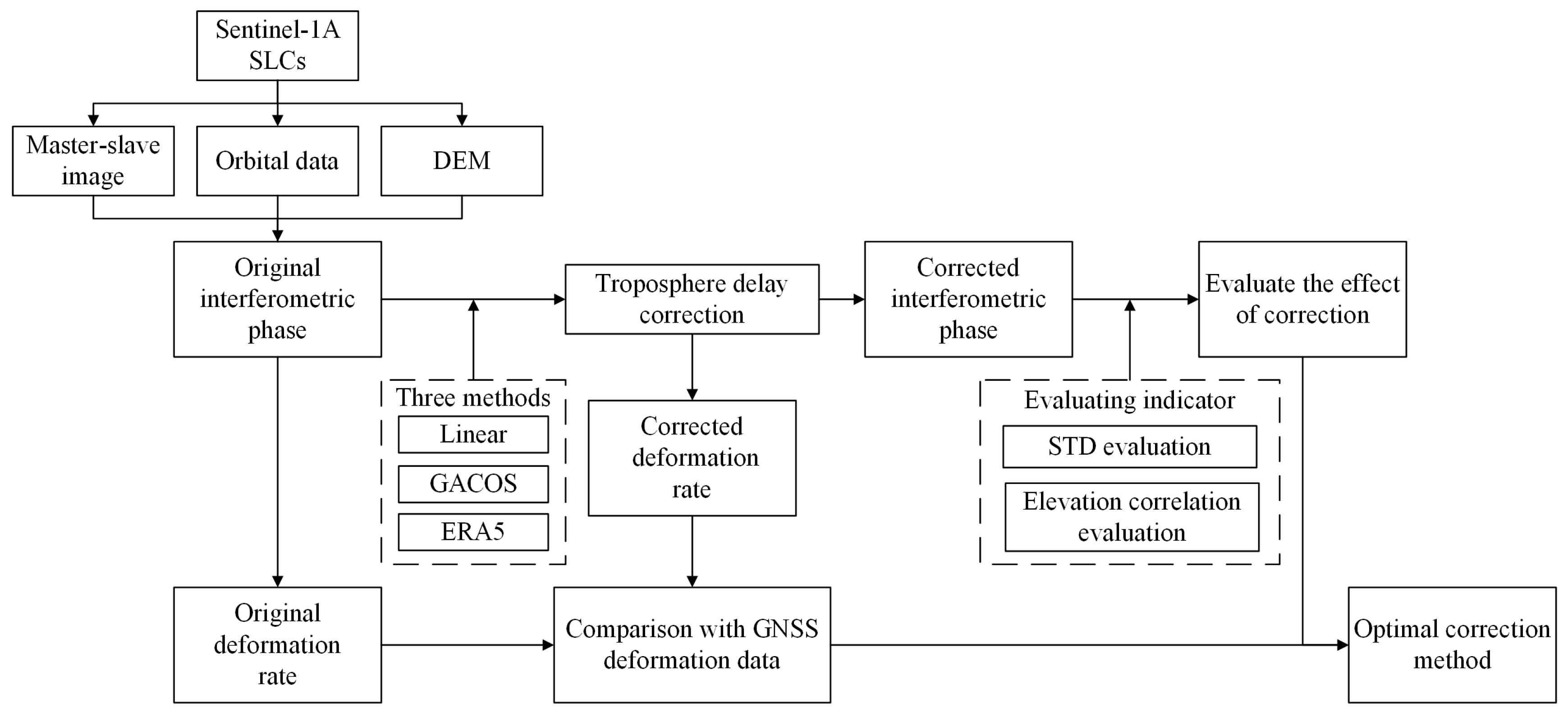
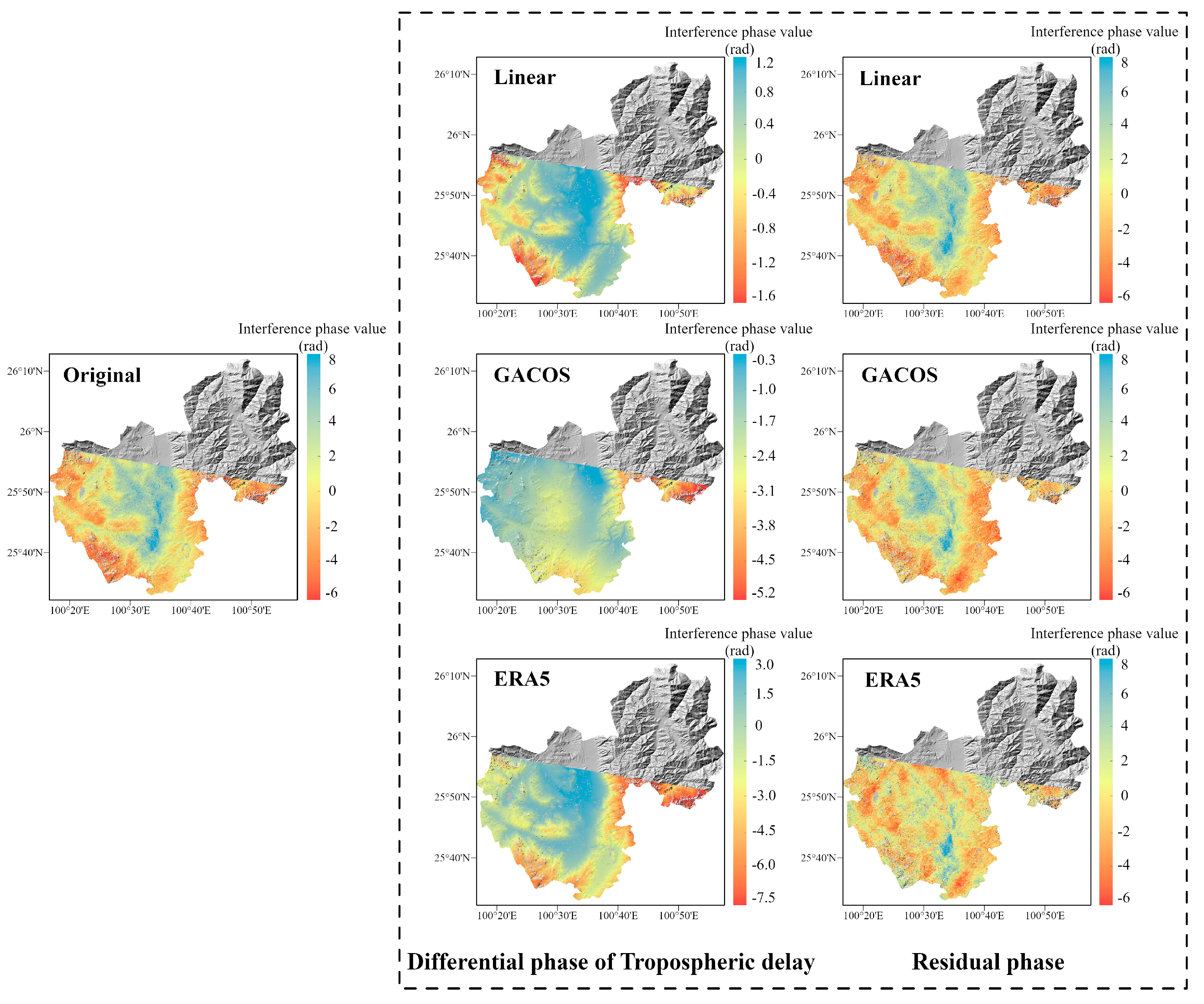
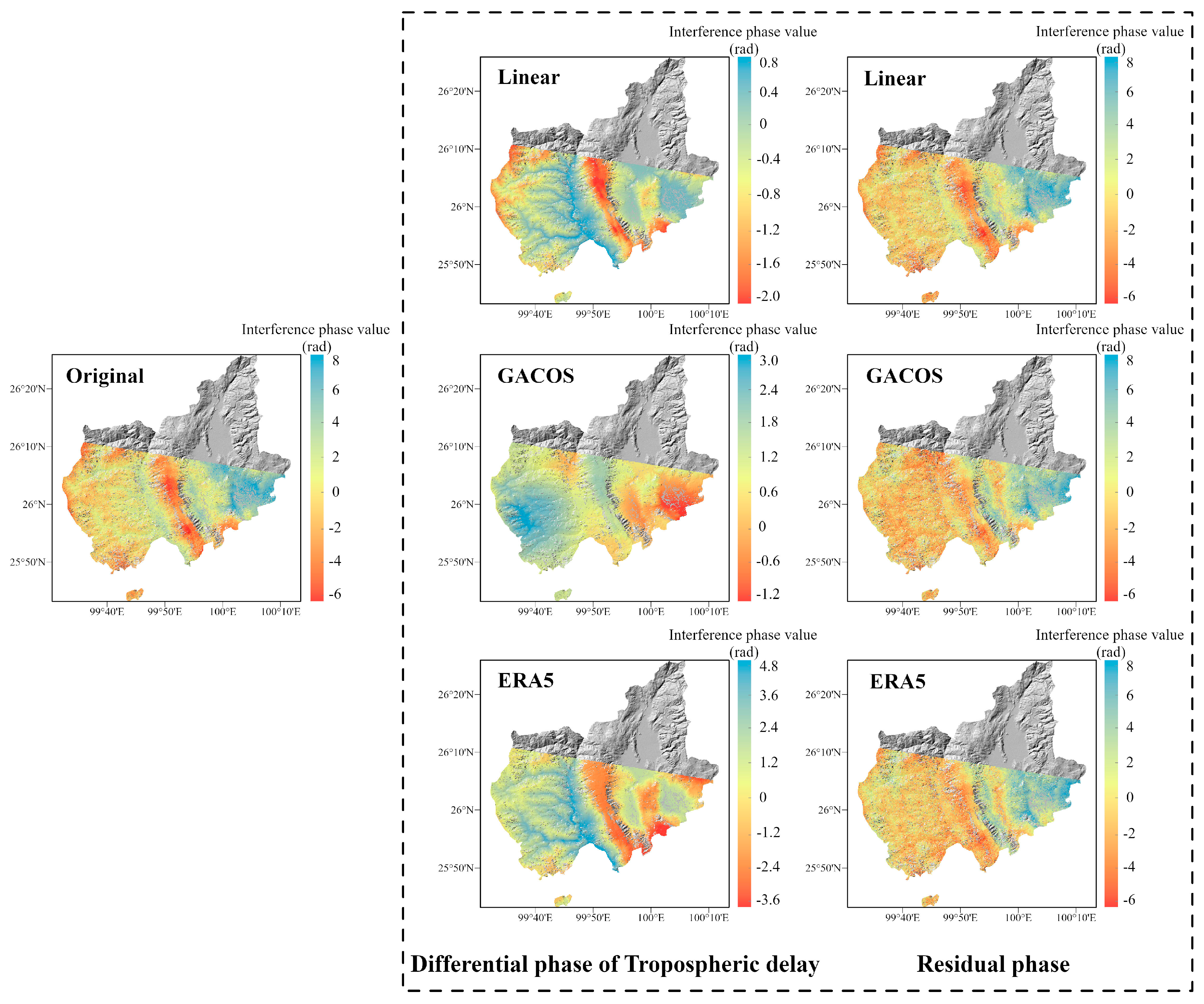
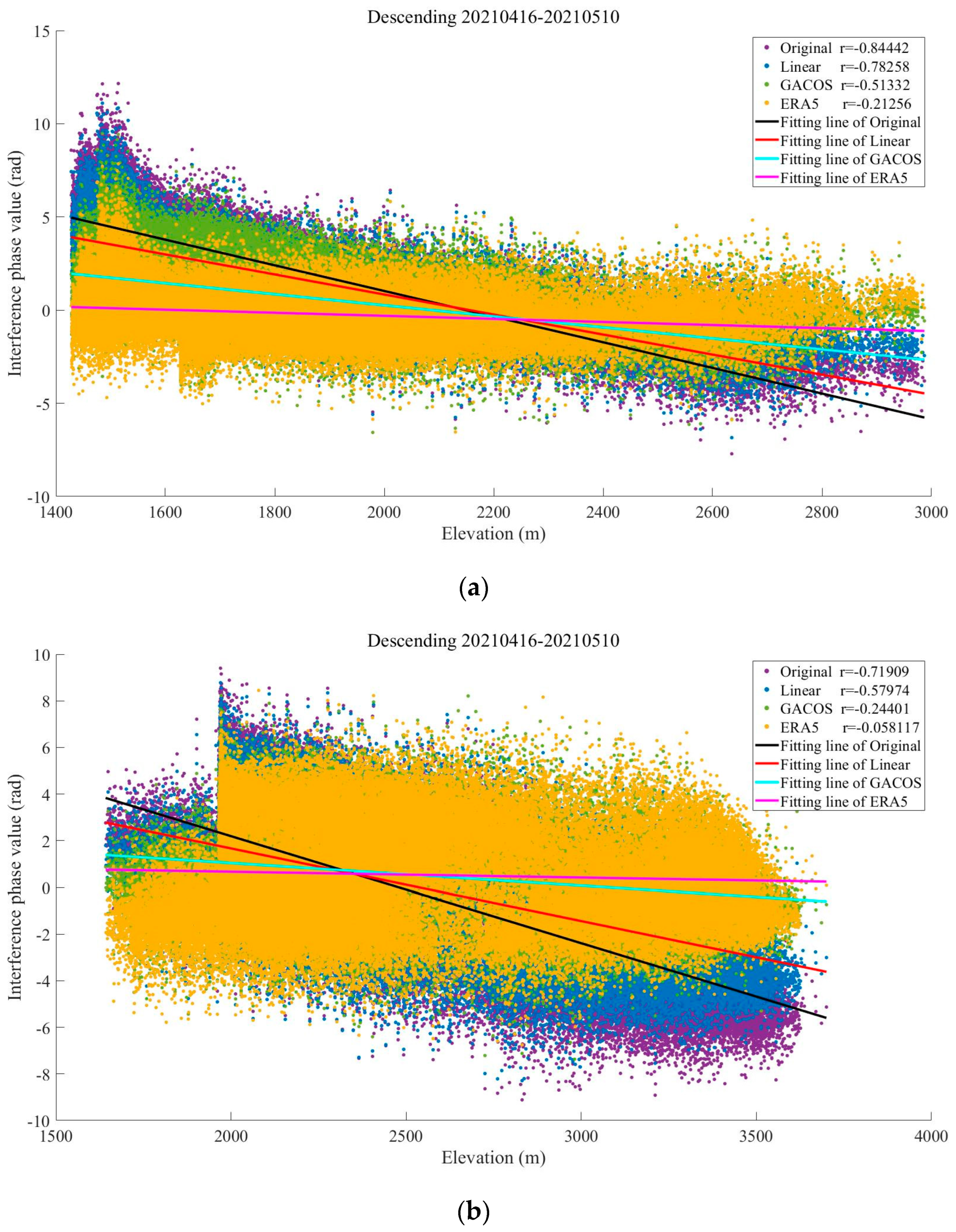
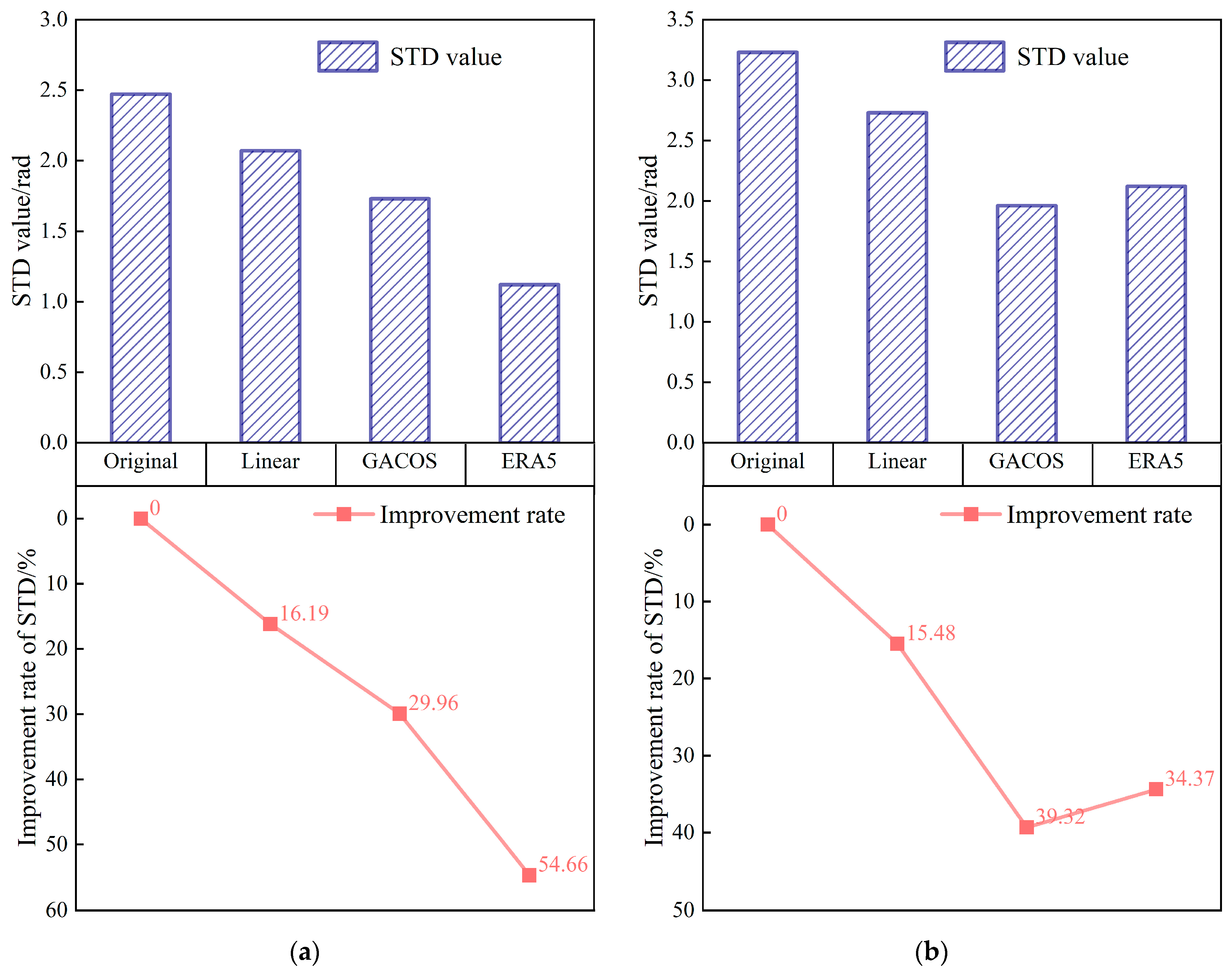

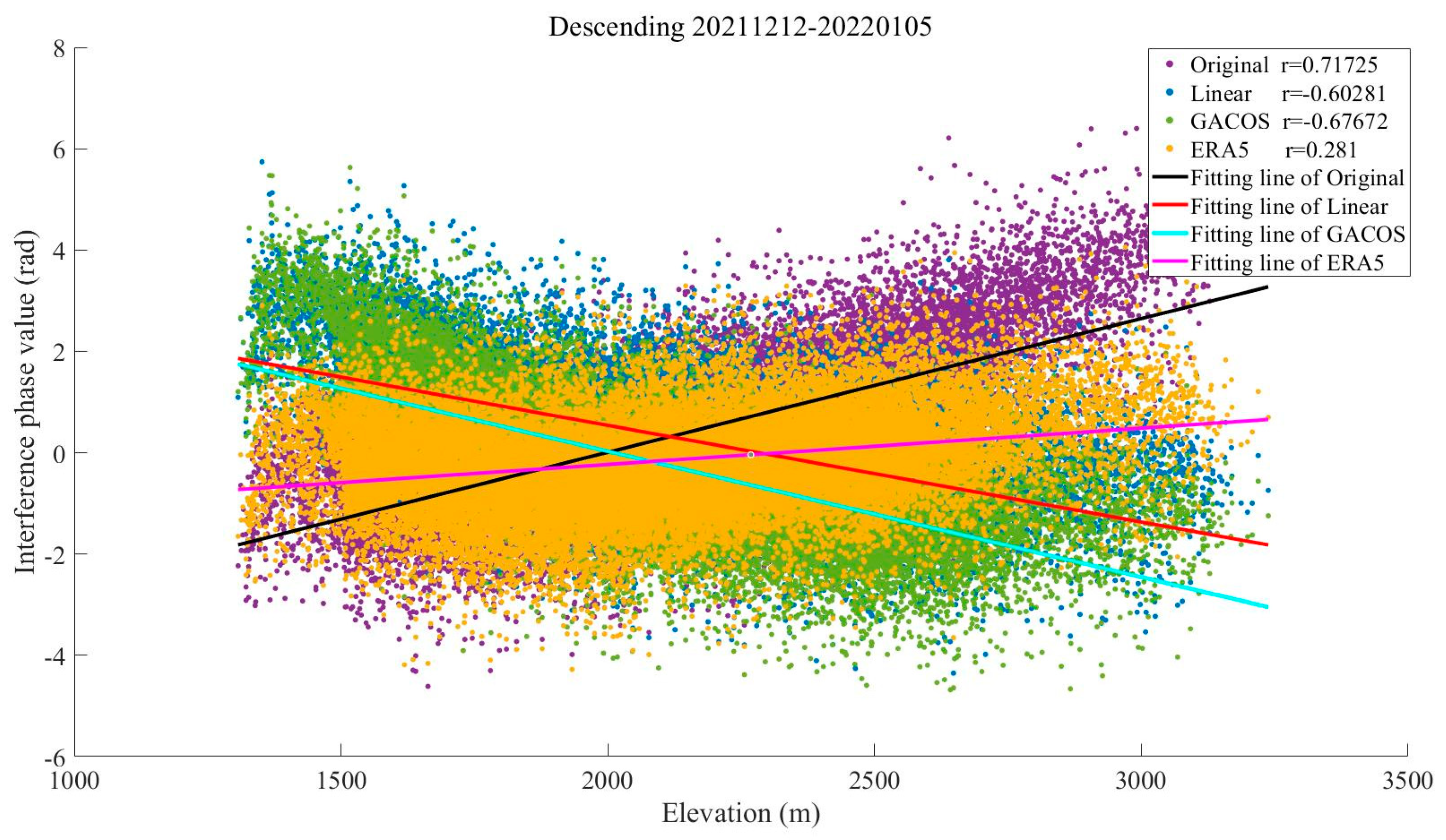
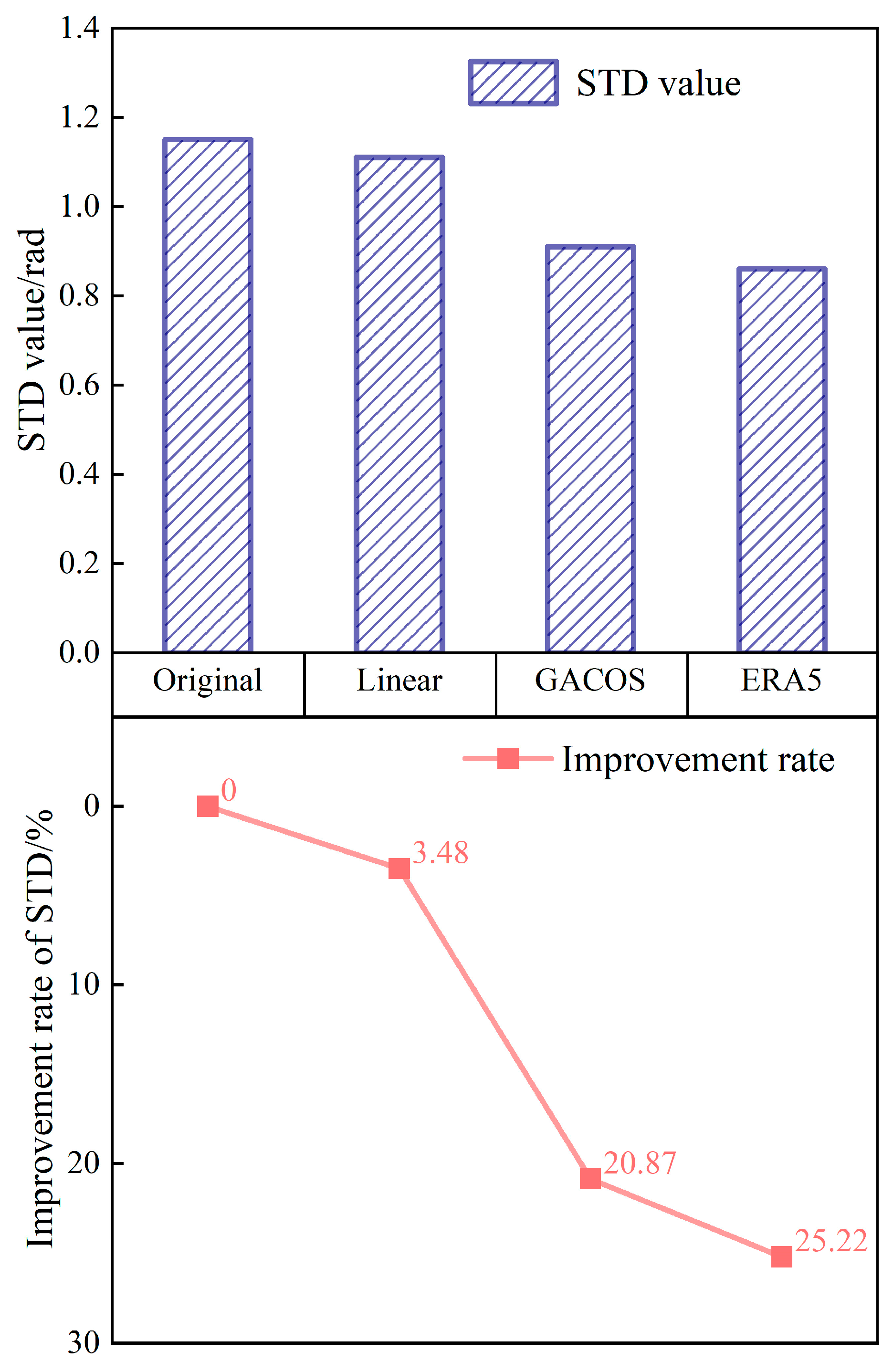



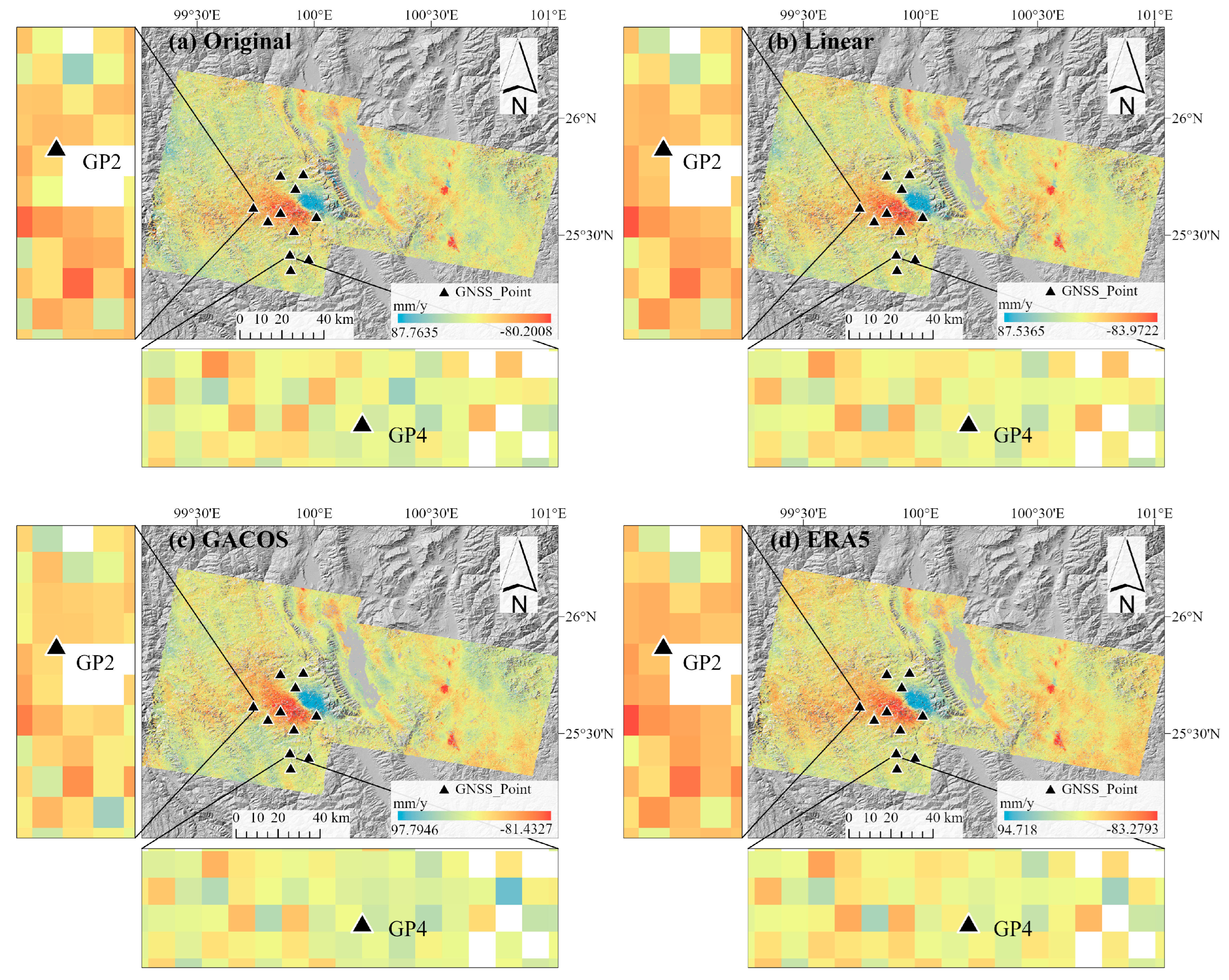


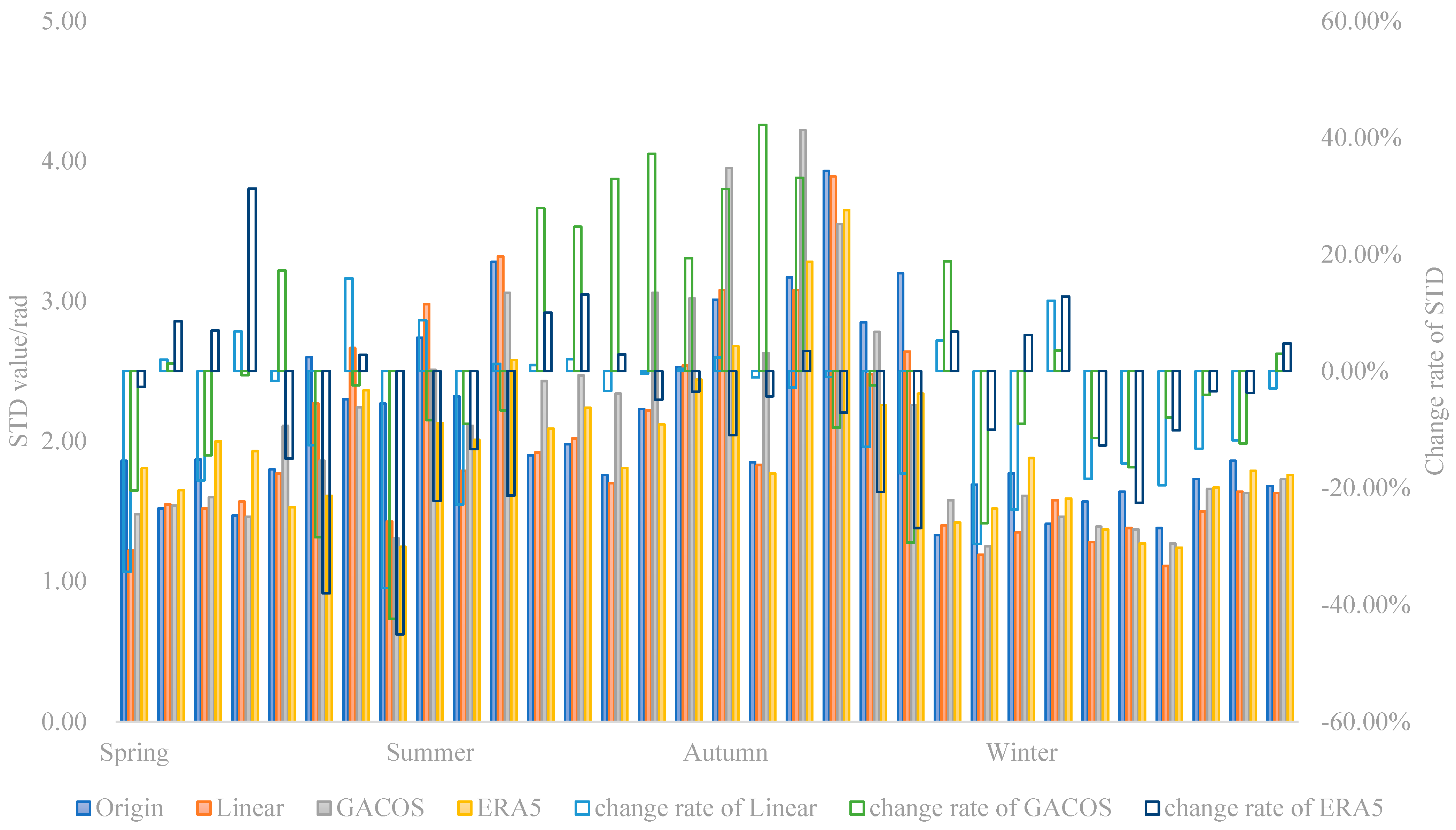


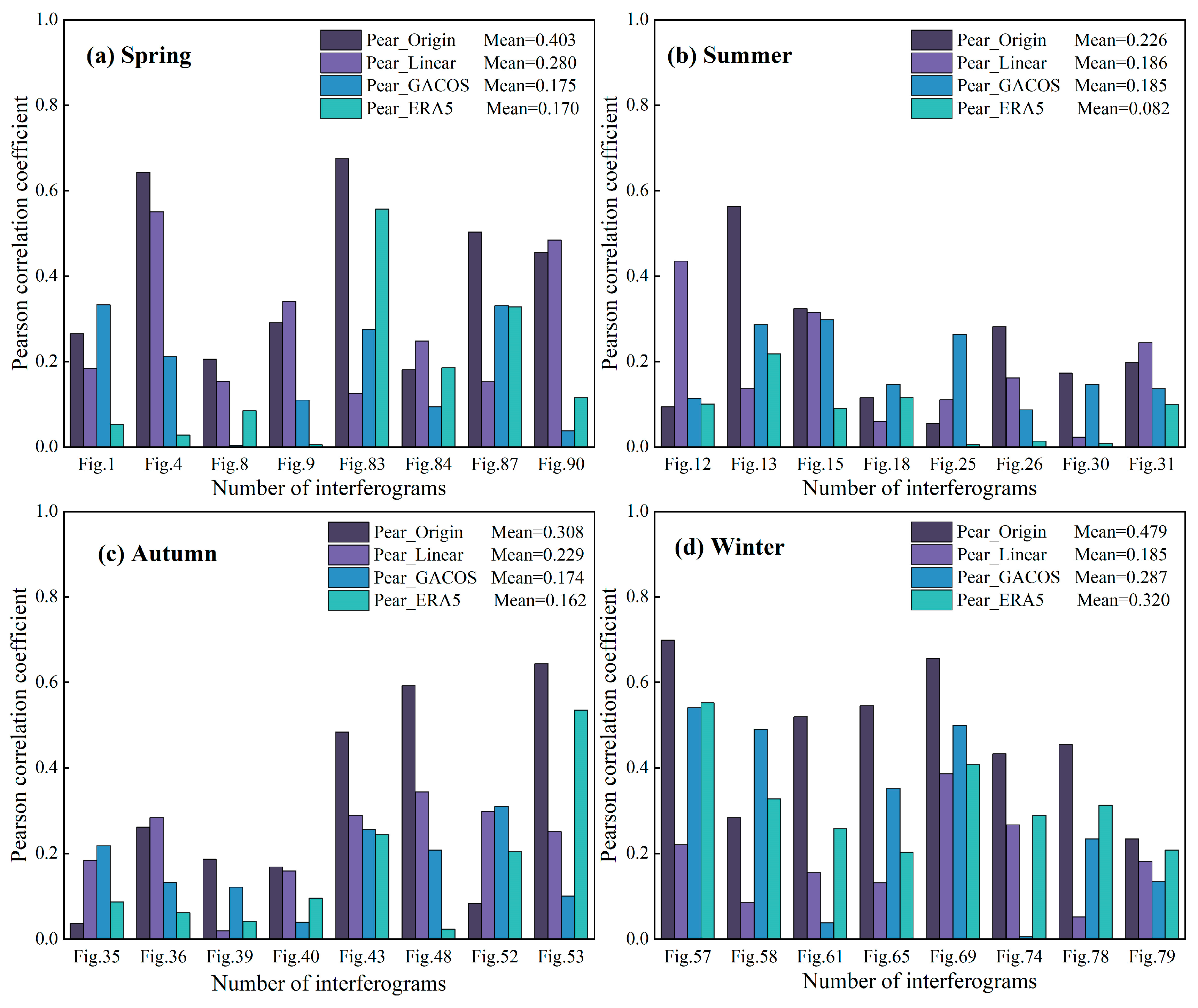
| Tracks | Number of Images | Time Coverage | Imaging Time (UTC) | Number of Interferograms |
|---|---|---|---|---|
| Descending | 25 | 4 April 2021–23 April 2022 | 23:14 | 92 |
| GNSS Point | RMSE of | RMSE of | RMSE of | RMSE of |
|---|---|---|---|---|
| Original | Linear | GACOS | ERA5 | |
| 1 | 14.69 | 5.05 | 12.76 | 3.40 |
| 2 | 37.94 | 39.07 | 38.72 | 38.06 |
| 3 | 125.90 | 127.44 | 129.65 | 126.74 |
| 4 | 4.11 | 3.41 | 5.62 | 4.83 |
| 5 | 12.89 | 9.45 | 10.69 | 11.13 |
| 6 | 18.53 | 11.50 | 17.11 | 8.92 |
| 7 | 5.56 | 8.09 | 10.34 | 10.63 |
| 8 | 3.32 | 6.33 | 5.45 | 7.02 |
| 9 | 136.42 | 118.95 | 120.29 | 115.70 |
| Mean | 39.93 | 36.59 | 38.96 | 36.27 |
| Number of Interferograms | Season | Time Coverage | Temporal Baseline (day) |
|---|---|---|---|
| FIG. 1, 4, 8, 9, 83, 84, 87, 90 | Spring | 22 February–3 June | 101 |
| FIG. 12, 13, 15, 18, 25, 26, 30, 31 | Summer | 3 June–26 August | 84 |
| FIG. 35, 36, 39, 40, 43, 48, 52, 53 | Autumn | 26 August–30 November | 96 |
| FIG. 57, 58, 61, 65, 69, 74, 78, 79 | Winter | 30 November–22 February | 84 |
| Season | Evaluation of Correction | Original | Linear | GACOS | ERA5 |
|---|---|---|---|---|---|
| Spring | Average of Phase Standard Deviation of All Figures | 1.96 | 1.73 | 1.66 | 1.67 |
| Improvement Rate | - | 11.73% | 15.30% | 14.80% | |
| Summer | Average of Phase Standard Deviation of All Figures | 2.38 | 2.28 | 2.59 | 2.12 |
| Improvement Rate | - | 4.20% | −8.82% | 10.92% | |
| Autumn | Average of Phase Standard Deviation of All Figures | 2.63 | 2.43 | 2.61 | 2.29 |
| Improvement Rate | - | 7.60% | 0.76% | 12.93% | |
| Winter | Average of Phase Standard Deviation of All Figures | 1.63 | 1.43 | 1.52 | 1.57 |
| Improvement Rate | - | 12.27% | 6.75% | 3.68% |
Disclaimer/Publisher’s Note: The statements, opinions and data contained in all publications are solely those of the individual author(s) and contributor(s) and not of MDPI and/or the editor(s). MDPI and/or the editor(s) disclaim responsibility for any injury to people or property resulting from any ideas, methods, instructions or products referred to in the content. |
© 2023 by the authors. Licensee MDPI, Basel, Switzerland. This article is an open access article distributed under the terms and conditions of the Creative Commons Attribution (CC BY) license (https://creativecommons.org/licenses/by/4.0/).
Share and Cite
Yang, Q.; Zuo, X.; Guo, S.; Zhao, Y. Evaluation of InSAR Tropospheric Delay Correction Methods in the Plateau Monsoon Climate Region Considering Spatial–Temporal Variability. Sensors 2023, 23, 9574. https://doi.org/10.3390/s23239574
Yang Q, Zuo X, Guo S, Zhao Y. Evaluation of InSAR Tropospheric Delay Correction Methods in the Plateau Monsoon Climate Region Considering Spatial–Temporal Variability. Sensors. 2023; 23(23):9574. https://doi.org/10.3390/s23239574
Chicago/Turabian StyleYang, Qihang, Xiaoqing Zuo, Shipeng Guo, and Yanxi Zhao. 2023. "Evaluation of InSAR Tropospheric Delay Correction Methods in the Plateau Monsoon Climate Region Considering Spatial–Temporal Variability" Sensors 23, no. 23: 9574. https://doi.org/10.3390/s23239574
APA StyleYang, Q., Zuo, X., Guo, S., & Zhao, Y. (2023). Evaluation of InSAR Tropospheric Delay Correction Methods in the Plateau Monsoon Climate Region Considering Spatial–Temporal Variability. Sensors, 23(23), 9574. https://doi.org/10.3390/s23239574







